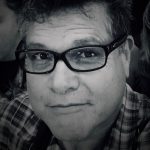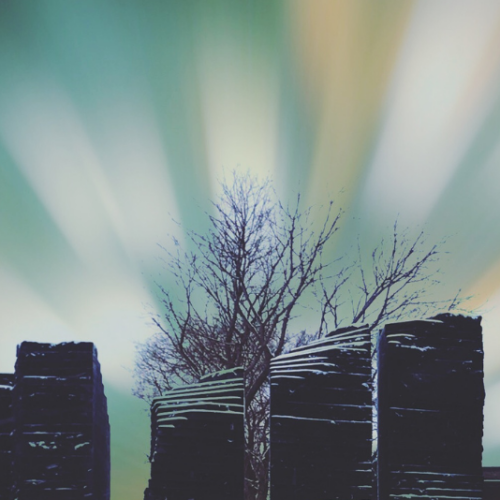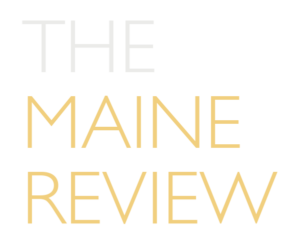My mother’s old room, mostly emptied of furnishings, has one wall lined with cardboard boxes. A system of organization has arisen first from her sorting, then from mine after she moved into assisted living. Boxes with photos of freckled relatives from Oklahoma on my dad’s side are separated from boxes of my mom’s people, of friends she went to church with, pictures of grandkids, as well as holiday cards, tax forms, medical papers, bills, bank statements, and old correspondence in flimsy airmail envelopes.
In the box of sepia-toned photos of my mom’s family in Nagasaki, Japan, her mother wears a kimono and her father a dark suit. In later pictures, he and her brother sport wartime khaki uniforms; the girls are in school outfits of white blouses with dark skirts. None of them smile as they stare straight ahead in these formal portraits. These somber pictures are in contrast to the many modern square-framed photos with vibrant Kodachromatic colors. In one set, all four sisters are grown up, less slender; my mother, her hair still black but permed, gazes back at the camera through oversized brown-tinted sunglasses.
Other boxes contain photos of my younger brother, of me, of both of us together. We’re poking our buzz cut heads into tide pools to inspect the tiny worlds temporarily cut off from the sea. Polaroids streaked by incomplete swabs of developer fluid reveal us in matching cowboy hats flanking our babysitter, shiny cap pistols drawing a bead on the viewer. I hold small slides up for the light to shine through. I find images of my childhood dog, Tip, who was my parents’ pet in Japan before I was conceived.
In one box, I’ve not coincidently placed a small bundle of official-looking government letters from the Atomic Energy Commission addressed to my father. Underneath those sits a stack of mailers to my mother, mostly in Japanese, from the Committee of Atomic Bomb Survivors in the United States of America.
My mother, in her dementia, deconstructed into their base elements what had once been carefully assembled photo albums, separating the pictures from the captions that identified them. I’m left guessing. My evaluation draws from my memories, much of it indirect hearsay. Some faces or places register, some don’t. It occurs to me that there’s a half-life to personal accumulations. In time, much of it is reduced to inert detritus, devoid of meaning or power to anyone living.
When I sift through them, I try to separate what still has life. Much of it looks like material for a documentary. Jocular baby-faced men in uniform gesture with drinks in hand. My mother and her younger sister, stylish in grey sweaters, cradle puppies and pose like actresses in a candid shoot for LIFE magazine. A neighbor sitting on a porch step shades her face and grins with lips pressed together, crinkling the corners of her eyes. I see events captured before my birth, during my parents’ time together in Japan, and know they must have importance, but I don’t feel anything. These are photos of other worlds inhabited by strangers. Even my parents seem almost unrecognizable, young and light-hearted, unusually happy.
I can see my father’s eye at work; he was an avid photographer. Most of the photographs are his. When he is in the picture (often with a hand-rolled cigarette between his fingers), I wonder who took the photo. I wonder who is out of the frame. The framing defines the image, limits the story being told—just as the placement of the beginning or ending shapes a narrative. A happy story is happy because of where the author decides to have the ending fall. If the frame is extended out further, it becomes unhappy. Further still, and it’s happy again. The story that unfolds from any event never really ends.
I suppose every family has a dark story somewhere in its past. I’m dismayed to find one black and white photo torn, the other half missing. My father is sitting on the floor on a futon with his legs folded to the side. He’s wearing a kimono robe of all things (I’d never seen him wearing one). Japanese shoji screens create a grid pattern of rice paper and dark wood in the background. This was my parents’ world before it came undone. I assume my mother took the photo because she’s not in the picture. There’s a little more hair on his head than I remember him having. He’s smiling and looking down to his left. I know he is gazing at an infant seated on the futon next to him—my older brother, who died when he was a year old of pneumonia. This was several years before I was born. I unearthed this forgotten photo some time back and, wanting to confirm my guess as to the identity of that baby, showed it to my mother. I regretted doing so upon seeing her expression grow hollow.
My mother attributed any problems that beset us to radioactivity—the death of her firstborn, the miscarriage of her second, her stomach ulcers, her parents’ dementia, my brother’s substance abuse, my father’s stroke. She wasn’t so much a human Geiger counter, simply on the lookout for passing particles to blame as she was, decades later, still helplessly carried in their turbulent wake.
Even though no one else agreed with her reasoning, her fears about radiation weren’t entirely baseless. Who really could know? Radiation had only appeared in civilians’ lives as a relatively new horror. Unseen, without sound or smell, it went through walls, penetrated the skin, and dove deep into cells. It seared, poisoned, and planted seeds in the marrow of bones for cancers to bloom years later. Hell, it could even scramble your DNA, extending its unwelcome reach through generations.
The story of when the atomic bomb dropped on my mother in Nagasaki was a regular topic of conversation growing up. For her, it never ended. The bomb, like a bright pebble in a dark pond, propagated waves of invisible light way into the future, through us and past us.
My father, on the other hand, almost never spoke of the nuclear device that detonated near him off the coast of San Diego. It was one in a series of exposures that were part of his work for the US military. The black and yellow radioactive glyph was always on a posted sign at his workplace for as long as I could remember.
When I was a boy, I fantasized about gaining superpowers because of it. My brother and I chased each other around the nuclear reactor where my father worked at the Naval Post-Graduate School, marveling at how heavy the lead bricks weighed that encircled the core. Each the size of a normal brick, but dark grey and so dense you could barely hold one up with both hands. Those bricks stopped the invisible atomic particles that otherwise could start an unwanted chain of events, like Superman’s chest shielding an innocent from a stream of bullets. Even then, I understood enough about the uncanny nature of radiation to be wary.
I still have a souvenir from that time—unearthed from the clutter in the family home—a small square cardboard tag that clipped to a shirt’s breast pocket on the left side. The guys that worked at the reactor, including my dad, wore them. Their names embossed in a dark plastic strip affixed to the tag. The cardboard sandwiched a slip of photographic film. If you had too much radiation in your blood, then the film would get exposed as the blood passed through your heart.
In later years when he worked at the school’s linear accelerator, I remember him saying that sometimes he and the other older guys would volunteer to do a task that might be risky for a younger man who hadn’t sired yet. I imagined him taking a drink from a stained coffee cup, then sliding his black-framed reading glasses into its soft case as he walked by chalkboards scrawled with equations and coworkers, who swiveled on their government-issued metal chairs to watch him ascend an iron catwalk and traverse the industrial cavern high above the concrete floor, so dangerously high he might as well have been a circus tightrope walker.
For my mother, always waiting for the other shoe to drop, there existed something of a safety net for her anxiety. Organized through the Committee of Atomic Bomb Survivors, Japanese doctors came out to San Francisco every couple of years or so to examine past residents of Hiroshima and Nagasaki. I’m sure they checked out the blood that flowed through my mom’s heart. I wondered how much the purpose of the examinations was humanitarian and how much an opportunity to monitor a unique group over time. Either way, it reassured my mother to go since they too vigilantly looked out for harm yet to be revealed.
The impact the atomic bomb had on my mother’s life can’t be overstated. Her world changed completely. One moment she was a young teenager playing hooky from school with a couple of friends; the next, she lay dazed in rubble. “What happened?” she said. “Your head is bleeding!” they replied.
She had been at the transit station on the outskirts of Nagasaki when the air raid sirens went off. The shelter there in the August humidity felt crowded and hot. When the all-clear sounded, she and her friends got out. Soon afterward, the siren blared again, but they didn’t want to go back inside because they needed to pee. In her telling of the aftermath, once they brushed off the dust and blood, they returned to the shelter to find it collapsed on the people inside.
The next day she joined a troop of neighborhood kids who made their way across the ruined landscape, curious to see what had become of their school. She told stories of people who survived, but not for long because they were burned. To make her point, my mother would act like a person desperate for a drink of water. “Mizu,” she pleaded. “Mizu.” Other stories were of people who at first seemed fine but later got sick. She mimed them pulling tufts of hair off their head, then regarding in dismay the handfuls they held.
My mother was animated in her presentations. She had the exaggerated expressions and vocal range of a Kabuki performer. Her impressions of great despair were riveting. I knew when she was acting and when she was making things up. Though these stories felt painfully real, they weren’t too painful to tell.
The untold stories, and the people inhabiting them, remained outside the frame. They could only be imagined, their contents inferred, similar in the way a missing puzzle piece eventually reveals itself through the shape of its absence. Now, with my mother’s mind coming apart with her dementia, fewer and fewer pieces remain connected. All will be lost.
Last August, I took my daughters to visit the Nagasaki Atomic Bomb Museum. So they could know more than just what had been said. My youngest was eleven, the same age when I last visited the area. The museum does not try to avoid presenting the miserable suffering the populace endured; its goal is to show visitors what must not be allowed to happen again. The haunting images and artifacts I remembered from long ago were still displayed, along with poignant personal stories. A portion of a wall had been reconstructed where the shadow of a ladder and a person standing beside it were burned by the blast into the wood. On seeing my daughters’ reactions to this and other exhibits, I wondered if I should have spared them. Their future is tied to this past, seen or unseen, so it is better to know, I think, than not.
My father, unlike my mother, was rational in his approach while hers was emotional. He attempted in vain to use logic and reason to get her to come around whenever they disagreed, to see his point-of-view before he eventually retreated in defeat. He actually was a sensitive man, understated most of the time. Once, when I had revealed at the kitchen table to another child that I had older brothers who died as babies, he later took me aside and gently said, “It’s best to not speak of it around your mother. The loss was very hard on her.” Which, for him to say, meant that she had wailed and wanted to die.
Later, after he had passed away, I learned from his siblings that my father had gone to great lengths to get my mother to the states. The American government was not in favor of him bringing home a Japanese bride. I think her grief had been so deep that he could not imagine abandoning her after all she had lost. So he pushed back and prevailed against the bureaucracy. Not that he said as much. He wouldn’t ever tell tales about anyone, even when they involved him. He might start to, then physically pull up and stop himself. He’d dismiss the notion with a wave of his hand, “Well, that’s neither here nor there.”
I can’t help but wonder if my parents would have gone on to have me if my older brother hadn’t died.
I often found things out accidentally because so much was unsaid. My father’s own government once secretly tested a nuke underwater 500 miles off the southernmost coast of California with his ship as part of a flotilla of sitting ducks. I only heard the details about it as a teenager when he received a thick official letter acknowledging possible exposure to harmful radiation from the 1955 event in what was code-named Operation Wigwam.
I suppose that letter opened a locked doorway. At some point, not long after I found out about his encounter with a nuclear detonation, my father mentioned in passing crewing on the USS Indianapolis. I had recently seen the movie Jaws, so I knew it was an ill-fated ship, which, before sinking in shark-infested waters, had delivered parts for the first atomic bomb so it could be dropped on Hiroshima. When I exclaimed, “What?” then mentioned all that, he gave a single, small nod, “Yes, the same.”
The crew of the Indianapolis was on a top-secret mission leaving the San Francisco shipyards within hours of the Trinity atomic test in New Mexico. They transported half the world’s enriched uranium and the parts necessary to assemble the weapon across the Pacific Ocean. The ship took 300 of the crew when it went down from Japanese torpedoes. Of the remaining 900 men who went into the water, only a third survived after several harrowing days. Its sinking was the single largest loss of life in the history of the US Navy. All this I knew before I ever knew his part in what were life-shattering events.
On further querying, he stated that he’d been on board for the trip as it traveled from California to Hawaii before he disembarked. He then flew to Guam where he met up with the vessel one last time before it departed. Honestly, I really don’t know how he felt about all that, about not being aboard when it went down or who he knew who never returned. Nor did he ever acknowledge the terrible irony that he helped deliver one bomb while my mother unknowingly awaited the other. He didn’t say or let on.
These stories felt selectively truncated, like the way a vignette applied to a photo blurs all but the center, so the image fuzzily fades toward nothing well before the actual edge. It’s an act of omission, a frame within a frame.
The implications ran through my head then and still do. If my father hadn’t left the ship before the last legs of its journey, he might have perished with most of the men on board. If my mother hadn’t needed to pee, then she would have died in the collapsed shelter. If the atomic bombs I’d always seen as an awful unleashing of misery hadn’t been used, then my parents certainly would never have met in a clothing shop near a US naval base south of Tokyo. Then I wouldn’t exist. My daughters wouldn’t exist. Nothing we, and a whole host of others, had done in our lives would ever have been. Cardboard boxes filled with photos and paperwork wouldn’t be sitting in an empty house waiting to be sorted.
Among all those boxes, there is no single photo with all of us, none that tell the whole story. The big picture is too big for a picture.
The photo I think captures the story of my parents most accurately is the one torn in half, the one of my oldest brother who I never knew, an image from a different world belonging to another family that appeared similar to mine.
I come across another photo that gets closer to representing a slice of my reality: a snapshot taken of a sunrise from the summit of Mt Fuji when I was eleven. There are no people in the picture, just the orange sun brilliantly peeking above a rumpled sea of clouds. I see that photo, and I remember everyone outside the frame, illuminated and facing the dawn. I know because I was there. I took that picture.

Albert McFarland
Albert McFarland resides in the rural coastal mountains of California where orange-bellied newts breed in the creek & wild turkeys roost in the redwoods. Historically he’s checked the box labeled “other.” He is currently writing a speculative fiction novel about luck.



